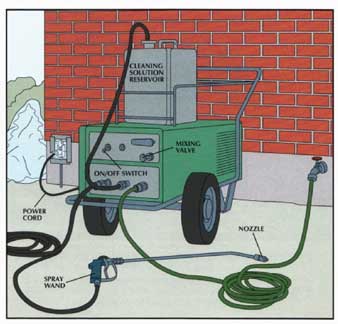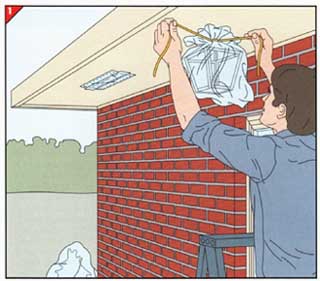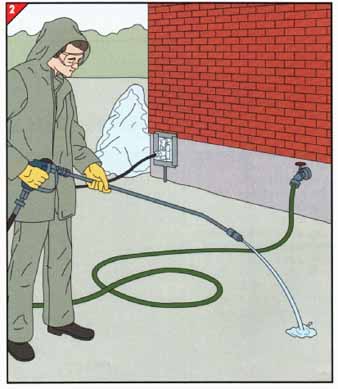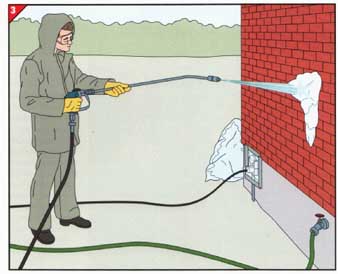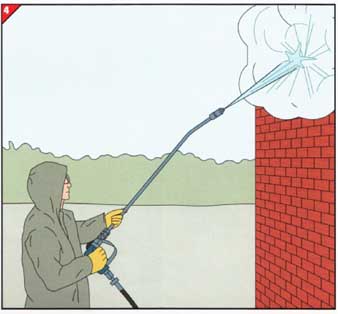Blasting Off Dirt with Water
| Home | Wiring | Plumbing | Kitchen/Bath |
|
Power washers—available at tool- rental agencies—can dramatically speed the cleaning of exterior walls, driveways, patios, and sidewalks. A powerful pump in the unit draws water from a faucet and blasts it at high pressure through a nozzle. The spray loosens and washes away dirt and grime. Choosing Equipment: While gas- powered washers can deliver water at greater pressure and volume, electric models are easier to use and are adequate for most small jobs. Each machine has a low-pressure nozzle for applying detergent and a selection of high-pressure nozzles for washing. The high-pressure nozzles disperse water in a wide or narrow stream; for most purposes, use one that delivers a 25-degree spray. Operating the Washer: Plain water is often used to blast away dirt, but you can add a detergent to boost the cleaning power. Choose a product designed for use with the washer, and adjust the dilution on the machine according to the instructions on the label. The pressure of the spray is regulated by a control on the machine or on the nozzle; however, have the rental agency set the pressure—typically 1500 pounds per square inch (psi) for wood and vinyl, and no more than 700 psi for brick. CAUTION _ Never point the nozzle at anyone—the high- pressure jet of water can cause severe injury. Before leaving the washer unattended, shut off the motor and squeeze the trigger to relieve the pressure. Never use a gas-powered unit indoors. SAFETY TIPS: Protect your eyes with goggles when operating a pressure washer. TOOLS: Pressure washer; Garden hose Setting up a power washer. Not all power washers are con figured like the one at right; ask the rental agency for a demonstration of how to hook up the hoses for your model. Usually a 3/4-inch garden hose connects the machine to an exterior faucet, and another hose, furnished with the unit, links the cleaning-solution container to the pump. A third hose, also provided, joins the spray wand and the unit. A mixing valve adjusts the dilution of the cleaning agent. For safety, plug the washer into an outlet protected by a ground-fault circuit interrupter (GFCI), or use an extension cord with a GFCI to connect it to an unprotected outlet. Shield the receptacle by taping plastic over it. /26 POWER-WASHING AN EXTERIOR WALL 1. Preparing the house. • Seal exterior electrical outlets and soffit vents with overlapping strips of plastic tape. • Close all doors and windows. • Protect nearby plants by draping them with large plastic bags or drop cloths. • Tie heavyweight plastic bags around outdoor light fixtures to protect them from water damage. • Water the earth around the wall thoroughly to dilute any cleaning chemicals that seep into the soil. 2. Venting the lines. • Put on goggles and gloves and, to keep dry, a hooded rain jacket and pants, and rubber boots. • Connect the hoses and turn the faucet on all the way. • Without turning the motor on, point the spray wand toward the ground and squeeze the trigger to vent air from the lines. • When a steady stream of water flows through the wand (r), release the trigger and snap the low-pressure spray nozzle onto the wand. //27 3. Applying the chemical. • Fill the cleaning-solution reservoir and open the mixing valve. • Turn on the motor; then, holding the wand about 2 feet from the wall, squeeze the trigger, and working from the bottom to the top of a section, move the wand back and forth in 6- to 8-foot strokes. • Turn off the unit and the mixing valve. Point the wand in a safe direction and pull the trigger to release the pressure. 4. Driving off the dirt. • Install a high-pressure nozzle with a 25-degree spray and vent the lines. Then turn the unit back on. • Grasp the spray wand firmly before squeezing the trigger so the recoil does not jerk the equipment out of your hands. Holding the wand about 1 foot away from a brick wall or 2 feet from wood or vinyl, aim at an inconspicuous spot and press the trigger. Quickly step away from the wall if there is any sign of damage to the surface; hold the wand further away and try again. • Starting at the top and working down, move the wand across successive sections of the wall in gentle side-to-side sweeps. //28 |
| HOME | Prev: Removing Grime from Masonry | Next: | Article Index |
